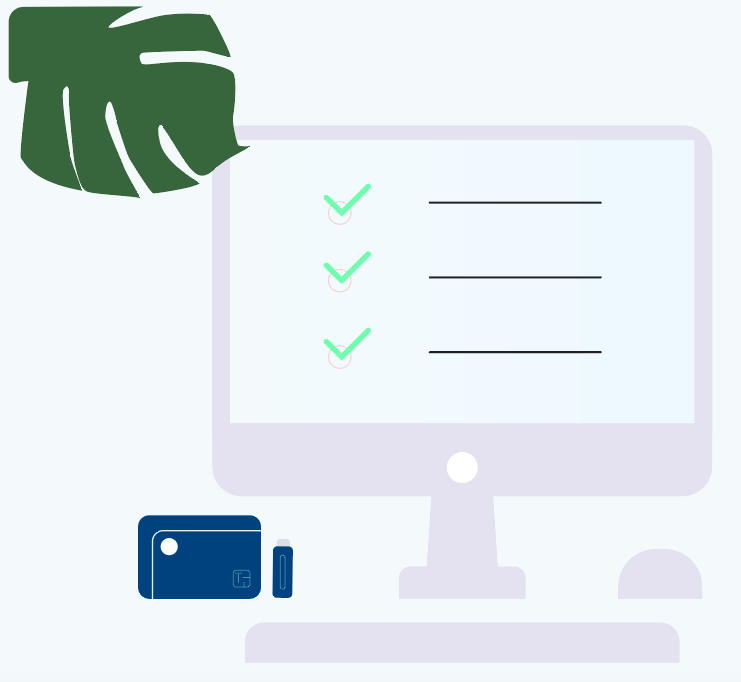

What is Employee e-ID?
Employee e-ID is a digital identity card and a tool for digital work tasks. The employee identifies themselves in their role as an employee instead of using their private e-ID. This creates security for both employee and employer. Common tasks:
- Reporting, for example to NAV or Altinn
- Digital signing
- Secure login on PC
The employee e-ID is linked to a person with a link to the company behind the digital action. The company owns and manages the e-ID and cancels it when the employee leaves.
Safety
When the employees use the Employee e-ID for reporting or digital signing, they are acting on behalf of the business. This makes it clear who is responsible for the action.
Areas of use Employee e-ID
Reporting
The employee e-ID can be used for reporting to public services, also where the employee otherwise uses their private e-ID, such as at Altinn.
Digital signing
Use the Employee e-ID to digitally sign documents, agreements or tenders. Signing with the Employee e-ID obligates the business, not the employee.
Access control
Employee e-ID is compatible with Microsoft AD and increases security through S/MIME authentication and central management of access.
Encryption
One of the functions of the Employee e-ID is end-to-end encryption. The encryption used is RSA with an option for elliptic curves.
Home office
The employee e-ID can be used for a secure home office solution and set up by the IT department as a VPN connection.
One card for everything
Gather the company's needs for security in the access card. Use the card for logging in, digital signing, access control and much more.
The public digitization strategy emphasizes:
“There is a need to be able to prove a connection between a person and a business in cases where the person signs on behalf of the business.”
Why Employee e-ID?
Less risk of fraud
When the employees use the Employee e-ID at work, they act digitally on behalf of their employer and avoid confusion with private identification. This creates security for all parties.
When an employee chooses to use their private BankID to sign a contract, doubts may arise as to whether the signature is legally binding for the business. An Employee e-ID removes all doubt.
If fraudsters get hold of a digital identity, it can in the worst case lead to the person’s bank account being emptied. For a company, there can be major consequences if unauthorized persons gain access to internal systems.
An Employee e-ID gives access to all public services, but not to logging into the bank. ID theft thus becomes less attractive, and both money and the company’s data are more secure.


Administration of e-ID
The E-ID Portal
When the company becomes a customer, you get access to the E-ID portal.
The portal makes it easy to manage the Employee e-ID.
OVERVIEW
The portal provides a full overview of which employees have an e-ID, and the status of deliveries and invoices.
ADMINISTRATION
With the E-ID Portal, administration becomes simple. You can order, cancel or renew your e-ID with a click. One or more administrators are given access to manage Employee e-ID for the company.
SSL reseller
The e-ID portal makes it easy to become an e-ID dealer. As a retailer, you can manage the e-ID for as many customers as you want without losing track of it.
Ordering and delivery
1. Order
You order the Employee e-ID via our website or in the E-ID Portal. For the first order, a person with a role in the Brønnøysund register must sign the order.
2. Register
The employee receives a link by e-mail to register their personal information. The employee must have a Norwegian social security number or D-number to be able to get Employee e-ID.
3. Pick up at the post office
A package of Employee e-ID is sent to the post office to which the employee belongs and collected on presentation of a passport. An SMS with a PIN code is sent to the person's mobile phone.
All needs in one place
The needs for security, access and digital signing are often different from department to department. Fortunately, one and the same Employee e-ID can solve many of the challenges in the company .
Employee e-ID has functions for authentication, signing and encryption and can solve challenges related to:
- Access control via Active Directory
- Access control by placing the Employee e-ID on the access card
- Reporting on behalf of the company
- Digital signing
- Access to Helsenett
- Home office solution with VPN

Areas of use divided by department
Finance and purchasing
- Signing tenders and contracts
- Issuance of payslips
- Reporting to Altinn
- Reporting to the Norwegian Tax Administration, the Norwegian Financial Supervisory Authority etc.
HR and management
- Reporting of sick leave
- Reporting to Altinn
- Signing of agreements
- Secure printing
Administration
- Reporting to Altinn
- Access card
- Signing of new hires
- Login on PC
IT and development
- Access control AD
- VPN client
- Signing and encrypted email
- PKI enabling of platform
Frequently Asked Questions
An increasingly large part of public services from the state, county and municipality are wholly or partly online. An electronic ID confirms that you are who you say you are, and is currently required to access these services.
Commfides’ Employee e-ID is an electronic ID at the highest level of security and is issued in accordance with Norwegian public requirements and EU standards. An Employee e-ID has functions for digital signing, authentication (login) and encryption of information.
Employee e-ID is a personal e-ID owned by a company and which identifies the company and the employee. The digital ID is located in a chip on a plastic card. The employee can use it to log in to the PC or to public digital services. It can also be used to sign documents.
Technically, the Employee e-ID is a digital certificate, a data file that contains information and a confirmation of your and the company’s identity. The identification process, which includes checking passports and a callback procedure for the company, is important because it is the basis for this confirmation.
Identity theft is a growing societal problem. If fraudsters gain access to your digital identity, it can in the worst case lead to your bank account being emptied. And for a company, there can be major consequences if unauthorized persons gain access to internal systems.
If an employee uses a private BankID to log in in a work context, it makes both the person and the company vulnerable to fraudsters. Employee e-ID is safer for both the company and the employee.
An Employee e-ID from Commfides can be used to log in to public services, but not to log into the bank. ID theft thus becomes less attractive, and both your money and your company’s data are more secure.
The principle of not using a private e-ID in a work context is also enshrined in the legislation, specifically in section 19 of eForvaltningsforskriften. Among other things, it states that use of the employee’s e-ID requires special approval.
Medium-sized and large businesses often have several departments with different needs in security, access and digital signing. By adding an Employee e-ID to the access card, you can tailor both physical and digital access the employees have in relation to their roles in the company.
With an Employee e-ID, the employee can be identified as connected to the business and log in to over 1,500 public services. The employee will also be able to use their e-ID to log on to services as a private person, for example Altinn and NAV.
The E-ID portal is a free and user-friendly tool for companies that use the Employee e-ID. It provides a complete overview of which people have an Employee e-ID in the company and makes ordering, renewal and administration easy.
In the E-ID portal, the company can order Employee e-ID and enterprise certificates as required and keep track of its certificates. The portal also shows the status of deliveries and invoices, and gives access to revoke or renew certificates.